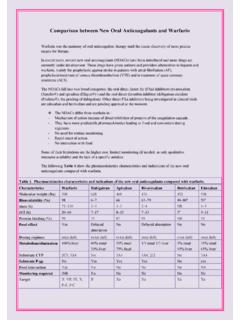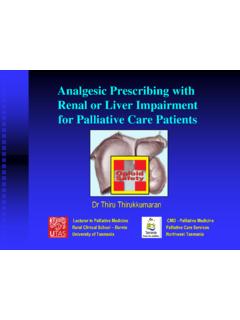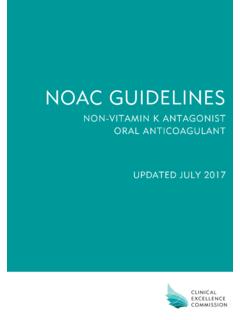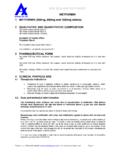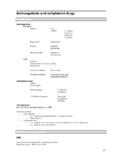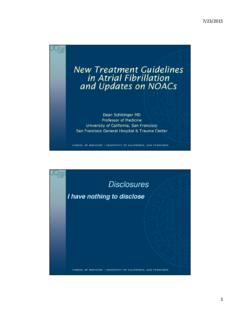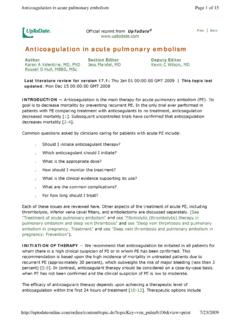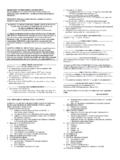Transcription of MOBIC 7.5 mg tablets. 2. QUALITATIVE AND QUANTITATIVE ...
1 MOBIC NZ DS v01 1 NEW ZEALAND DATA SHEET 1. PRODUCT NAME MOBIC mg tablets. 2. QUALITATIVE AND QUANTITATIVE COMPOSITION One MOBIC mg tablet contains mg of meloxicam. Excipient(s) with known effect: Each tablet contains mg of lactose monohydrate. For full list of excipients, see section 3. PHARMACEUTICAL FORM Tablet. Pale yellow, round, uncoated tablets, marked 59D on one side, with break bar and company logo on the other side. 4. CLINICAL PARTICULARS Theraputic indications Symptomatic treatment of painful osteoarthritis (arthrosis, degenerative joint disease).
2 Symptomatic treatment of rheumatoid arthritis. In patients for whom longer-term use may be required, treatment efficacy should be reviewed within the first month of treatment and MOBIC withdrawn if there is a lack of therapeutic benefit. Patients on long-term treatment should be reviewed regularly, such as every three months with regards to efficacy, risk factors and the ongoing need for treatment. The decision to prescribe a selective COX-2 inhibitor should only be made after assessment of the individual patient's overall risk for developing severe adverse events history of cardiovascular, renal, or gastrointestinal disease, and after use of alternative therapies such as non- pharmacological interventions and simple analgesic therapy where these have been found to lack analgesic efficacy or to have unacceptable adverse effects.
3 Dose and method of administration Dose As the potential for adverse reactions increases with dose and duration of exposure, the shortest duration possible and the lowest effective daily dose should be used in all patients. The total daily dose of MOBIC should be administered as a single dose. The maximum recommended daily dose is 15 mg. Painful Osteoarthritis: mg/day. If necessary, the dose may be increased to 15 mg/day. Rheumatoid arthritis: 15 mg/day. According to the therapeutic response, the dose may be reduced to mg/day. MOBIC NZ DS v01 2 Special populations In patients with an increased risk of adverse reactions a history of gastrointestinal disease or risk factors for cardiovascular disease, the treatment should be started at a dose of mg/day (see section ).
4 Renal impairment No dose reduction is required in patients with mild or moderate renal impairment ( in patients with a creatinine clearance of greater than 25 mL/min). In non-dialysed patients with severe renal impairment MOBIC is contraindicated (see section ). In patients with end-stage renal failure on haemodialysis the maximum daily dose should not exceed mg per day. Paediatric population The maximum recommended daily dose for adolescents aged 12 to 18 years is mg/kg and should not exceed 15 mg. MOBIC tablets are contraindicated in children below 12 years of age because the strengths of these dosage forms do not allow appropriate dosing in this age group (see section ).
5 Method of administration MOBIC tablets are swallowed with water or other fluid in conjunction with food. Contraindications Patients with known hypersensitivity to meloxicam or any excipient of the product (see section ) Rare hereditary conditions that may be incompatible with an excipient of the product (see section ) Use in patients who have developed signs of asthma, nasal polyps, angioedema or urticaria following the administration of aspirin or other non-steroidal anti-inflammatory drugs (NSAIDs) because of a potential for cross sensitivity Active or recent gastrointestinal ulceration/perforation Active inflammatory bowel disease (Crohn s Disease or Ulcerative Colitis) Severe hepatic insufficiency Non-dialysed severe renal insufficiency Overt gastrointestinal bleeding, recent cerebrovascular bleeding or established systemic bleeding disorders Severe uncontrolled heart failure Patients who have previously had a myocardial infarction or stroke Peri-operative pain in the setting of cardiac surgery, including coronary artery bypass graft (CABG)
6 , or major vascular surgery Use in children below 12 years of age Pregnancy or lactation Special warnings and precautions for use Gastrointestinal effects As with other NSAIDs, gastrointestinal bleeding, ulceration or perforation, potentially fatal, can occur at any time during treatment, with or without warning symptoms or a previous history of serious gastrointestinal events. The consequences of such events are generally more serious in the elderly. Caution should be exercised when treating patients with a history of upper gastrointestinal disease.
7 Patients with gastrointestinal symptoms should be monitored. MOBIC should be withdrawn if gastrointestinal ulceration or bleeding occurs. MOBIC NZ DS v01 3 As with other NSAIDs, caution should be exercised in patients receiving treatment with anticoagulants. Only one in five patients who develop a serious upper Gl adverse event on NSAID therapy is symptomatic. It has been demonstrated that upper GI ulcers, gross bleeding or perforation, caused by NSAIDs, appear to occur in approximately 1% of patients treated for 3-6 months, and in about 2-4% of patients treated for one year.
8 These trends continue, thus increasing the likelihood of developing a serious Gl event at some time during the course of therapy. However, even short- term therapy is not without risk. Most spontaneous reports of fatal GI events are in elderly or debilitated patients and therefore special care should be taken in treating this population. Studies have shown that patients with a prior history of ulcer disease and/or gastrointestinal bleeding and who use NSAIDs have a greater than 10-fold higher risk of developing a gastrointestinal bleed than patients with neither of these factors.
9 Caution is advised in patients most at risk of developing a gastrointestinal complication with NSAIDs: the elderly, patients using any other NSAID or aspirin concomitantly or patients with a prior history of or recent gastrointestinal disease such as ulceration and gastrointestinal bleeding. NSAIDs should be prescribed with caution in patients with a prior history of or recent ulcer disease or gastrointestinal bleeding. For high risk patients, alternate therapies that do not involve NSAIDs should be considered. Minor upper GI problems, such as dyspepsia, are common and may occur at any time during NSAID therapy.
10 Therefore, physicians and patients should remain alert for ulceration and bleeding, even in the absence of previous Gl tract symptoms. Patients should be informed about the signs and/or symptoms of serious Gl toxicity and the steps to take if they occur. Cardiovascular and cerebrovascular effects NSAIDs may increase the risk of serious cardiovascular thrombotic events, myocardial infarction, and stroke, which can be fatal. This risk may increase with duration of use. Patients with cardiovascular disease or risk factors for cardiovascular disease may be at greater risk.










